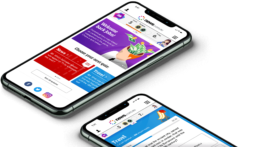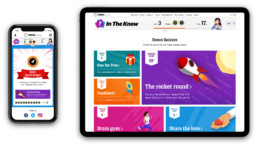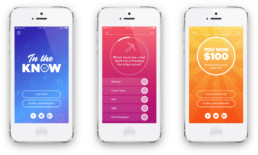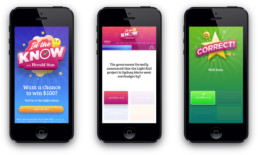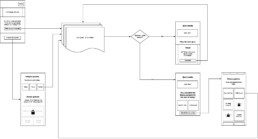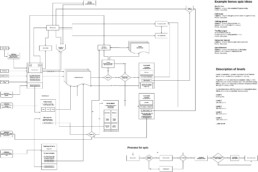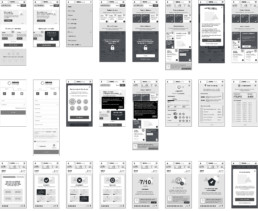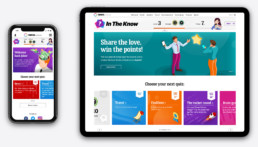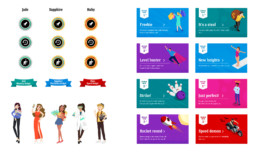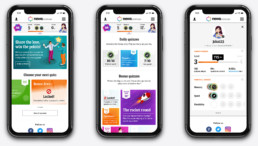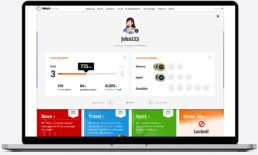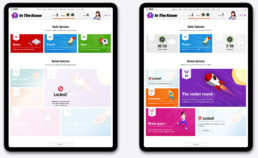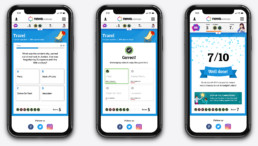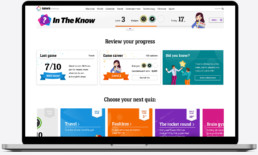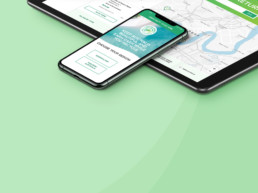Process
The development of the game occurred over a number of different projects which News Corp tasked the The Works with over the course of a year or so. The first project focused on creation of a prototype to demo to the business, the second made the game a reality via a Proof of Concept, and the final project took an MPV of the game to large audience via news.com.au.
I worked across these projects from being the creator of the initial prototype, to leading the UX, UI and game-concept design of the final MVP.
Taking a holistic view across projects, the game development followed the phases of the British Design Council Double Diamond process. Click below to skip to a stage in the project if you wish:
Discover
‘Demo’ prototype
Although not strictly part of the UX discovery, this was an important step in securing corporate backing and funding for the project.
In response to a brief from our client, I designed and built a high-fidelity prototype using Framer In a week-long design sprint. Featuring animation, video and sound, this interactive prototype imagined what a few rounds of the ‘In The Know’ news quiz game could look like. Its purpose was to grab the attention and imagination of News Corp global executives – it achieved this goal and funding for the project was secured.
Proof of concept
Before running a game like this on one of their high-value masthead sites, the client wanted to run a proof of concept for a limited time with a limited audience from their user base. Using the concept I created for the ‘demo’ as a starting point, a project team including myself undertook a ‘divergent’ ideation and design exercise in which various concepts for the game mechanic and visual styles for the game were explored.
Three separate design concepts were finalised and taken to focus groups. The preferred concept was developed on a modest budget and run under its own URL for a few months. The site would validate the demand for such a game and serve as a testbed, generating insights for the next project.
Define
MVP Brief
Using the proof of concept we had created, our client conducted research among their user base, insights from this were fed into our new brief: to deliver designs for an MVP of the ‘In The Know Game’, which would this time be run on one of the highest trafficking sites in Australia: news.com.au.
Key elements of the brief were:
- The game would need to be accessible to casual players, prioritising simplicity and a low barrier to entry. A daily cash prize would be available.
- This would need to be balanced with enough depth, challenge and incentive to keep regular players returning indefinitely.
- The game mechanic would need to integrate with News Corps’ marketing contact strategy and have flexibility to incorporate promotions in future.
- The game would have it’s own unique brand identity, but would be run within, and would need to align comfortably with, news.com.au
- The visual style adopted for the Proof of Concept was too childish and kitsch for the news.com.au audience, but nevertheless the new game should retain a ‘fun’ element and be visually engaging.
Develop
Ideation - game mechanic
My first priority was arriving at a game mechanic that would be easy and compelling to play for casual users, but which would be interesting and rewarding enough for players to keep coming back in the long term.
I ideated some concepts and presented these to the internal team and some third parties, inviting comments and criticism to get a feel as to whether the concepts were appealing and whether they would satisfy the brief. A clear favourite emerged and was approved in principle by our client:
The game mechanic
- The game would be composed of individual quizzes, each with 10 timed questions.
- Three new ‘standard’ quizzes would be available each day and would score 1 point per question.
- A bonus area with higher scoring quizzes and different quiz mechanics, would be unlocked when the standard games for that day had been completed.
- Some bonus games would be unlocked only once additional actions were completed or player status criteria reached.
- A daily cash prize would be available – users would gain one entry to the draw per point scored that day.
- Points would be accumulated over a players ‘lifetime’ in the game and would result in players ‘levelling up’ over time.
- Playing the game in a certain manner (e.g. answering questions fast) would earn users ‘badges’ in the game.
Game process flows / low fidelity wireframes
Using Lucidchart I began to map out a process flow chart for the game mechanic. This initially covered the flow through a single game, but grew to cover a user’s flow through multiple levels of games and to cover flows through other states such as user stats, winner announcement screens etc.
This chart became a working document shared between us and the client.
The flow chart informed basic wireframes for key game state screens which were incorporated into the chart it-self to provide a clear view of how the game would work.
Integration with marketing strategy
As UX lead, I worked collaboratively with our marketing strategist to establish how the game mechanic would integrate with marketing strategy and promotions to maximise user engagement and serve the clients wider marketing goals.
Detailed wireframes
Building on the early wireframes captured in my Lucidchart, I set about designing more detailed wireframes for key game screens. These were very valuable in giving stakeholders a better idea of how the game would be laid out and developers were included in reviews at an early stage, since in this Agile project they would begin development before design was complete.
Guerrilla user testing
The timescales and budget for the MVP project would not allow for formal user testing with detailed prototypes during the design phase. However I saw significant risk in progressing through detailed design and initial development without validating our assumptions.
I arranged for some low-cost face-to-face guerilla user testing aimed at:
- Validating the appeal of the game concept.
- Validating game introduction and selection screen layouts to ensure they helped users understand how to play.
- Testing user reactions to some preliminary branding and visual design references.
The testing was kept simple using static prototypes on a phone screen, plus references on paper, but provided great insights without the expense of a fully interactive prototype.
Deliver
Branding and game look and feel
Having received positive feedback on preliminary explorations in the development phase I worked these into formal logo concepts for the new brand. The user feedback proved useful in helping the client decide on a preferred brand concept.
Arriving at an approved look and feel for the game involved some negotiations with news.com.au brand guardians – our research had suggested that users would be engaged by an element of fun in the visuals which was not typically ‘on brand’ so finding an acceptable compromise was a key challenge of the visual design.
In-game assets and illustrations
Some of the in-game icons and graphic sets were created by me, while some (for example the player avatars) were created by a junior designer under my supervision and art direction.
The isometric style chosen for game illustrations was selected to to appeal to the audience (fun but not childish), but also since consistent looking graphics of this type could be sourced from stock – ensuring that the game always appeared to have fresh content would help maintain interest amongst regular players.
UI design
A mobile-first approach to the design was taken, aiming for an app-like experience on mobile devices. Desktop designs were also completed once mobile had been signed off.
